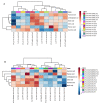Time-of-Day Circadian Modulation of Grape-Seed Procyanidin Extract (GSPE) in Hepatic Mitochondrial Dynamics in Cafeteria-Diet-Induced Obese Rats
- PMID: 35215423
- PMCID: PMC8876123
- DOI: 10.3390/nu14040774
Time-of-Day Circadian Modulation of Grape-Seed Procyanidin Extract (GSPE) in Hepatic Mitochondrial Dynamics in Cafeteria-Diet-Induced Obese Rats
Abstract
Major susceptibility to alterations in liver function (e.g., hepatic steatosis) in a prone environment due to circadian misalignments represents a common consequence of recent sociobiological behavior (i.e., food excess and sleep deprivation). Natural compounds and, more concisely, polyphenols have been shown as an interesting tool for fighting against metabolic syndrome and related consequences. Furthermore, mitochondria have been identified as an important target for mediation of the health effects of these compounds. Additionally, mitochondrial function and dynamics are strongly regulated in a circadian way. Thus, we wondered whether some of the beneficial effects of grape-seed procyanidin extract (GSPE) on metabolic syndrome could be mediated by a circadian modulation of mitochondrial homeostasis. For this purpose, rats were subjected to "standard", "cafeteria" and "cafeteria diet + GSPE" treatments (n = 4/group) for 9 weeks (the last 4 weeks, GSPE/vehicle) of treatment, administering the extract/vehicle at diurnal or nocturnal times (ZT0 or ZT12). For circadian assessment, one hour after turning the light on (ZT1), animals were sacrificed every 6 h (ZT1, ZT7, ZT13 and ZT19). Interestingly, GSPE was able to restore the rhythm on clock hepatic genes (Bmal1, Per2, Cry1, Rorα), as this correction was more evident in nocturnal treatment. Additionally, during nocturnal treatment, an increase in hepatic fusion genes and a decrease in fission genes were observed. Regarding mitochondrial complex activity, there was a strong effect of cafeteria diet at nearly all ZTs, and GSPE was able to restore activity at discrete ZTs, mainly in the diurnal treatment (ZT0). Furthermore, a differential behavior was observed in tricarboxylic acid (TCA) metabolites between GSPE diurnal and nocturnal administration times. Therefore, GSPE may serve as a nutritional preventive strategy in the recovery of hepatic-related metabolic disease by modulating mitochondrial dynamics, which is concomitant to the restoration of the hepatic circadian machinery.
Keywords: Zeitgebers; circadian rhythms; clock genes; grape-seed procyanidin extract; hepatic metabolism; mitochondrial dynamics; nutrition; obesity.
Conflict of interest statement
The authors declare no conflict of interest. The funders had no role in the design of the study; in the collection, analyses, or interpretation of data; in the writing of the manuscript, or in the decision to publish the results.
Figures








Similar articles
-
Grape-Seed Proanthocyanidin Extract (GSPE) Modulates Diurnal Rhythms of Hepatic Metabolic Genes and Metabolites, and Reduces Lipid Deposition in Cafeteria-Fed Rats in a Time-of-Day-Dependent Manner.Mol Nutr Food Res. 2024 Dec;68(23):e2400554. doi: 10.1002/mnfr.202400554. Epub 2024 Nov 11. Mol Nutr Food Res. 2024. PMID: 39523911 Free PMC article.
-
Rhythm and ROS: Hepatic Chronotherapeutic Features of Grape Seed Proanthocyanidin Extract Treatment in Cafeteria Diet-Fed Rats.Antioxidants (Basel). 2023 Aug 12;12(8):1606. doi: 10.3390/antiox12081606. Antioxidants (Basel). 2023. PMID: 37627601 Free PMC article.
-
Grape-Seed Procyanidin Extract (GSPE) Seasonal-Dependent Modulation of Glucose and Lipid Metabolism in the Liver of Healthy F344 Rats.Biomolecules. 2022 Jun 17;12(6):839. doi: 10.3390/biom12060839. Biomolecules. 2022. PMID: 35740964 Free PMC article.
-
Mechanistic insight into nuclear receptor-mediated regulation of bile acid metabolism and lipid homeostasis by grape seed procyanidin extract (GSPE).Cell Biochem Funct. 2017 Jan;35(1):12-32. doi: 10.1002/cbf.3247. Cell Biochem Funct. 2017. PMID: 28083965 Review.
-
Effects of Grape Seed Proanthocyanidin Extract on Obesity.Obes Facts. 2020;13(2):279-291. doi: 10.1159/000502235. Epub 2020 Feb 28. Obes Facts. 2020. PMID: 32114568 Free PMC article.
Cited by
-
Do You Have Problems When Reproducing Bioactivities of Food or Food Components? The Importance of Biological Rhythms.Nutrients. 2022 Nov 2;14(21):4607. doi: 10.3390/nu14214607. Nutrients. 2022. PMID: 36364869 Free PMC article.
-
Abrupt Photoperiod Changes Differentially Modulate Hepatic Antioxidant Response in Healthy and Obese Rats: Effects of Grape Seed Proanthocyanidin Extract (GSPE).Int J Mol Sci. 2023 Dec 2;24(23):17057. doi: 10.3390/ijms242317057. Int J Mol Sci. 2023. PMID: 38069379 Free PMC article.
-
Grape-Seed Proanthocyanidin Extract (GSPE) Modulates Diurnal Rhythms of Hepatic Metabolic Genes and Metabolites, and Reduces Lipid Deposition in Cafeteria-Fed Rats in a Time-of-Day-Dependent Manner.Mol Nutr Food Res. 2024 Dec;68(23):e2400554. doi: 10.1002/mnfr.202400554. Epub 2024 Nov 11. Mol Nutr Food Res. 2024. PMID: 39523911 Free PMC article.
-
Grape Seed Proanthocyanidins Mitigate the Disturbances Caused by an Abrupt Photoperiod Change in Healthy and Obese Rats.Nutrients. 2022 Apr 27;14(9):1834. doi: 10.3390/nu14091834. Nutrients. 2022. PMID: 35565801 Free PMC article.
-
Rhythm and ROS: Hepatic Chronotherapeutic Features of Grape Seed Proanthocyanidin Extract Treatment in Cafeteria Diet-Fed Rats.Antioxidants (Basel). 2023 Aug 12;12(8):1606. doi: 10.3390/antiox12081606. Antioxidants (Basel). 2023. PMID: 37627601 Free PMC article.
References
-
- Hüttemann M., Helling S., Sanderson T.H., Sinkler C., Samavati L., Mahapatra G., Varughese A., Lu G., Liu J., Ramzan R., et al. Regulation of Mitochondrial Respiration and Apoptosis through Cell Signaling: Cytochrome c Oxidase and Cytochrome c in Ischemia/Reperfusion Injury and Inflammation. Biochim. Biophys. Acta Bioenerg. 2012;1817:598–609. doi: 10.1016/j.bbabio.2011.07.001. - DOI - PMC - PubMed
MeSH terms
Substances
Grants and funding
LinkOut - more resources
Full Text Sources

